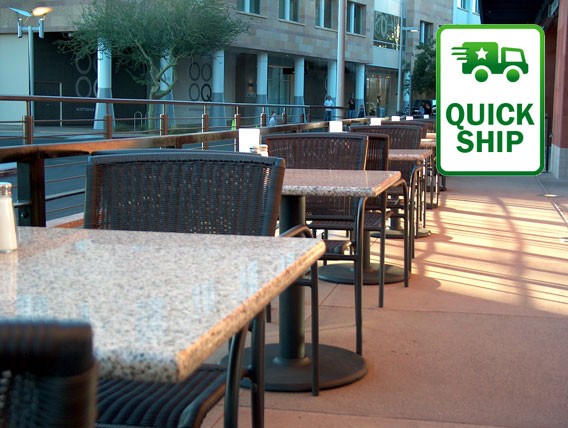When you are looking for outdoor furniture for your restaurant, you want a perfect balance of quality, durability, ability to withstand extreme weather, and affordability. With so many outdoor furniture material available on the market, a new buyer might get intimidated easily.
Best Material for Outdoor Furniture
Before you decide one the material for the outdoor furniture, let’s discuss the relevant features, pros, and cons of frequently encountered materials.
1. Wood:
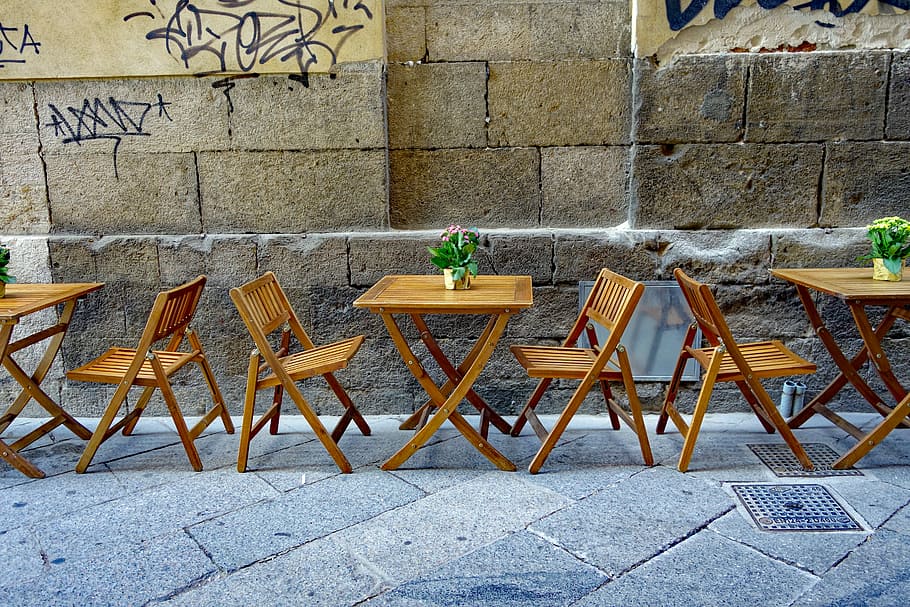
Wood has long been a popular choice of raw material for outdoor patio furniture. In particular, teak continues to be the most sought after material due to its natural look and favorable characteristics. Because it has a high natural oil content, teak repels water and can act as an all-weather outdoor furniture material for your restaurant. Its higher strength, availability, ease of maintenance, and long-life make it a durable material for outdoors.
2. Stainless Steel:
High density and strength of stainless steel make it an excellent choice for making heavy-duty commercial outdoor furniture material. It is resistant to rusting and corrosion, and can sustain extreme temperatures. The weight of stainless steel furniture means it is less likely to blow away or tip over under harsh winds. Stainless steel outdoor furniture continues to be a rewarding investment in restaurants.
3. Aluminum:
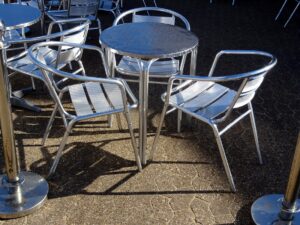
Because of its light weight, aluminum remains one of the most popular and go-to choices for outdoor restaurant furniture. Aluminum is strong, easily machine able, long lasting, and doesn’t cost a fortune. Although aluminum offers considerable resistance to corrosion, additional powder coating not only adds to the visual appeal and finish, but it also helps resist against scratches.
4. Resin/Plastic:
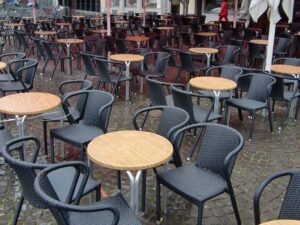
Modern minimalistic designs continue to use synthetic resins and plastics for restaurant furniture. With cutting edge technologies, these materials are available in a variety of shapes, sizes, colors, and finishes. Since coloring forms an inherent process during molding, these inexpensive, lightweight materials are fade resistant. Some pieces are lightweight, so make sure you have a way to secure them in windy weather conditions.
5. Metal:
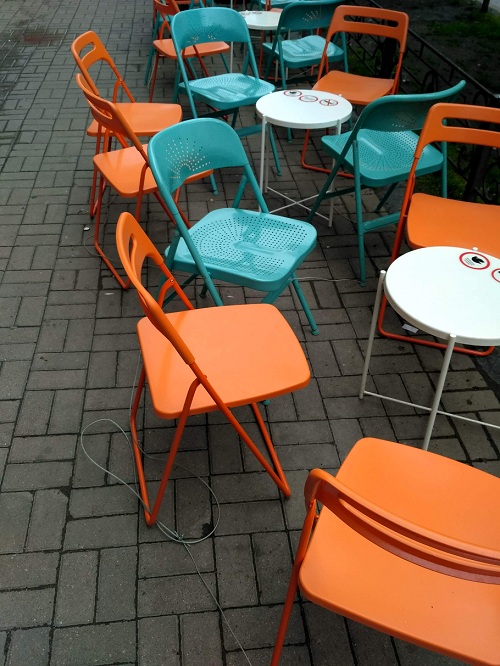
Wrought iron remains one of the oldest materials used for making furniture. Its strength and ductility make it an excellent choice for hand-crafted furniture. However, it can rust which may require extra care and proper maintenance. Additionally, in weather extremes, it may get too uncomfortable to use without upholstery.
Things to Consider Before Choosing Outdoor Furniture Material
Now that you are aware of the different materials to select from, let’s discuss some important that you must consider while choosing the best material for outdoor restaurant furniture:
i) Cleaning and Care:
While buying outdoor furniture is a one-time process, maintaining and cleaning it requires continued and constant effort. If you are short on time or don’t want frequent care, go for lower maintenance materials like teak, aluminum, stainless steel, or plastic.
ii) Eco-friendliness:
In the current times of accelerated climatic changes due to global warming, it’s a wise decision to opt for “green” materials. Thankfully, several leading manufacturers are becoming ecologically responsible and using recycled or biodegradable materials.
iii) Cost-effective:
For most of the buyers, the bottom line often rests on the cost of the furniture and their budget. However, before opting for a particular material, consider the upfront investment as well as the maintenance or repair costs in the longer run.
iv) Weight:
The weight of outdoor tables and chairs is an important consideration because the furniture may need to be moved daily. At many restaurants, closing time involves staff stacking the outdoor chairs under cover or placing them in a secured area to prevent theft. When the restaurant opens next, the furniture must be un-stacked and returned to its proper position. Heavy outdoor restaurant chairs aren’t practical, because it can be difficult for the staff to move them. Fortunately, lightweight outdoor restaurant chairs, available in a variety of designs and styles, make setup and breakdown a breeze.
v) Rain and Moisture:
Rain and moisture are probably the most damage causing agents to the outdoor furniture. If yours is an area with frequent rains or excessive humidity, ensure that your outdoor furniture has sufficient protection against rust, fungi, corrosion, etc. These factors not only degrade the life and durability of the furniture, but they can also pose a health concern for your customers.
vi) Corrosion Resistance:
Corrosion can be a serious problem in outdoor furniture. When untreated wrought iron is exposed to moisture in the air, a reddish powdery substance called iron oxide, or rust, forms. As metal rusts, it becomes weaker and appears corroded. Aluminum offers a corrosion-resistant option for restaurant owners who prefer the sleek, modern look of metal outdoor restaurant chairs. A zinc plating process makes cast iron outdoor patio bases resistant to corrosion, which allows restaurant owners to take advantage of iron’s sturdiness without having to worry about rust.
vii) Fungal Resistance:
Mold and mildew are fungal growths that find a hospitable environment in the tiny surface irregularities of untreated wood. Spores float through the air and settle on the wood, starting a decay process that makes the chair or table appear weathered and unkempt. Teak tabletops provide the warmth and appeal of natural wood, while offering unmatched durability. It can be allowed to weather naturally to a silvery grey or can be oiled twice a year to preserve the rich color.
viii) Ultraviolet Resistance:
The effects of the sun can be damaging to outdoor chairs constructed from natural materials. Wicker chairs are a popular choice for outdoor patios because they are lightweight and comfortable, but wicker woven from natural rattan or reeds deteriorates quickly from the effects of UV radiation. PE wicker (sometimes called “resin wicker”) provides the same artisan aesthetic and lightweight in a material that’s resistant to UV radiation.
Conclusion:
As you plan to buy the perfect outdoor furniture for your restaurant, realize it all boils down to your preferences, requirements, prevailing weather conditions, and budget. Hopefully, you can use this quick guide to make an informed decision while shopping for your favorite outdoor furniture.

